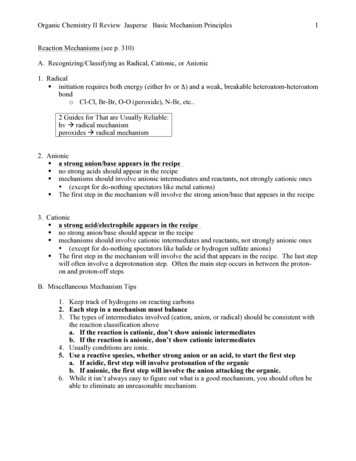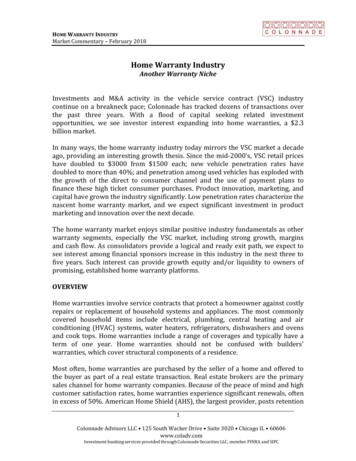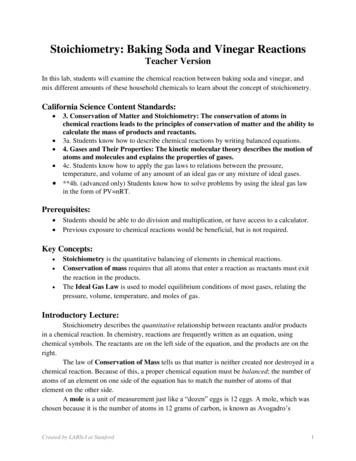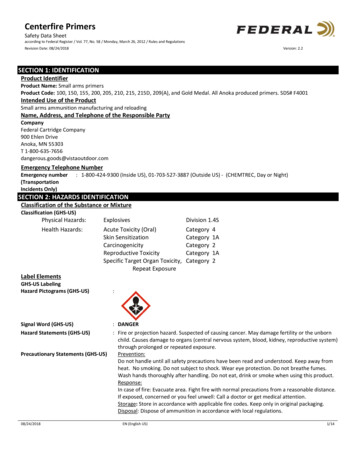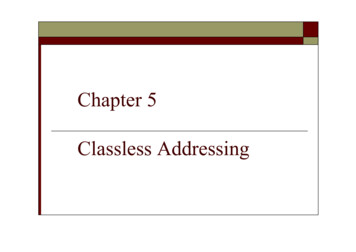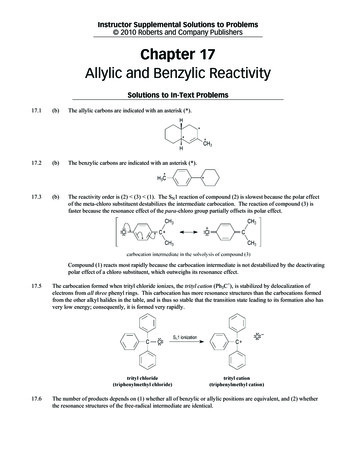
Transcription
Instructor Supplemental Solutions to Problems 2010 Roberts and Company PublishersChapter 17Allylic and Benzylic ReactivitySolutions to In-Text Problems17.1(b)The allylic carbons are indicated with an asterisk (*).17.2(b)The benzylic carbons are indicated with an asterisk (*).17.3(b)The reactivity order is (2) (3) (1). The SN1 reaction of compound (2) is slowest because the polar effectof the meta-chloro substituent destabilizes the intermediate carbocation. The reaction of compound (3) isfaster because the resonance effect of the para-chloro group partially offsets its polar effect.Compound (1) reacts most rapidly because the carbocation intermediate is not destabilized by the deactivatingpolar effect of a chloro substituent, which outweighs its resonance effect.17.5The carbocation formed when trityl chloride ionizes, the trityl cation (Ph3C ), is stabilized by delocalization ofelectrons from all three phenyl rings. This carbocation has more resonance structures than the carbocations formedfrom the other alkyl halides in the table, and is thus so stable that the transition state leading to its formation also hasvery low energy; consequently, it is formed very rapidly.17.6The number of products depends on (1) whether all of benzylic or allylic positions are equivalent, and (2) whetherthe resonance structures of the free-radical intermediate are identical.
INSTRUCTOR SUPPLEMENTAL SOLUTIONS TO PROBLEMS CHAPTER 172(a)All allylic positions of cyclohexene are chemically equivalent, and the two resonance structures are identical.Hence, only one allylic bromination product is possible.(e)A benzylic hydrogen is abstracted from the isopropyl group rather than a hydrogen of the two methyl groupsbecause a more stable benzylic free-radical intermediate is obtained.17.7(b)Because the two Grignard reagents in rapid equilibrium are identical, only one product is obtained:17.8(b)The benzylic proton is abstracted; b-elimination gives a vinylic ether.17.10(b)(d)
INSTRUCTOR SUPPLEMENTAL SOLUTIONS TO PROBLEMS CHAPTER 17317.11(b)17.12PCC oxidizes all primary alcohols to aldehydes and all secondary alcohols to ketones; MnO2 oxidizes only allylic orbenzylic alcohols (primary alcohols to aldehydes and secondary alcohols to ketones).(b)(d)17.13(a)17.14(b)Because one carbon is lost as a result of the oxidation, and because the benzene ring accounts for all fourdegrees of unsaturation, compound B must be ethylbenzene.17.15(b)Caryophyllene is a sesquiterpene because it contains three isoprene skeletons, which are shown as heavybonds.
INSTRUCTOR SUPPLEMENTAL SOLUTIONS TO PROBLEMS CHAPTER 17417.16(b)Ionization of geranyl pyrophosphate is followed by reaction with the pyrophosphate anion on the otherelectron-deficient carbon of the resonance-stabilized carbocation; rotation about a single bond is followed byionization of pyrophosphate to give the desired carbocation.17.17(b)Geranyl pyrophosphate is converted into farnesyl pyrophosphate by a mechanism exactly analogous to theone shown in Eq. 17.38 on text p. 765. Then farnesyl pyrophosphate hydrolyzes to farnesol; see text Eq.17.39.
INSTRUCTOR SUPPLEMENTAL SOLUTIONS TO PROBLEMS CHAPTER 17Solutions to Additional Problems17.19The structure of the starting material is:(a)(b)(c)(d)As in the previous parts, all four stereoisomers of each compound are formed.5
INSTRUCTOR SUPPLEMENTAL SOLUTIONS TO PROBLEMS CHAPTER 17Don’t forget that Grignard reagents undergo a very rapid allylic rearrangement (Eq. 17.23,text p. 799).(e)17.2017.23Compound (d) is a terpene. The isoprene skeleton is shown with heavy bonds.(b)Compound (b) is not a terpene.(d)Compound (d) is a terpene. The isoprene skeleton is shown with heavy bonds.(f)Compound (f) is not a terpene.(a)The allylic-rearrangement product B [(E)-1-bromo-2-butene] could be formed by ionization to a carbocationand bromide ion followed by reaction with the bromide ion on the other electron-deficient carbon.The curved-arrow notation is shown in the following scheme.(b)(c)17.24As in the previous part, all four stereoisomers of each compound are formed.(a)Compound B, the rearrangement product, is favored at equilibrium because it has the double bond with thegreater number of alkyl branches.6
INSTRUCTOR SUPPLEMENTAL SOLUTIONS TO PROBLEMS CHAPTER 177(d)(f)Compare the solutions to parts (e) and (f) and notice how reversing the sequence of theoxidation and nitration steps brings the directing effects of different substituents into playduring nitration.(g)17.25The compounds that give the most stable carbocation intermediates are the ones that undergo the most rapidsolvolysis. This problem deals with the effect of substituent on the stability of the carbocation intermediate. Thekey is to analyze the balance of resonance and polar substituent effects just as you would for electrophilic aromaticsubstitution. The order of increasing reactivity is (4) (1) (3) (2). Thus, compound (2) reacts most rapidlybecause the carbocation intermediate is stabilized by the electron-donating resonance effect of the p-methoxysubstituent:As in electrophilic substitution, the resonance effect of the p-methoxy group strongly outweighs its electronwithdrawing polar effect. In compound (3), there is a similar resonance effect; however, the polar effects of halogensubstituents outweigh their resonance effects. Consequently, compound (3) reacts more slowly. The nitro groupexerts no resonance effect in the carbocation intermediates derived from compounds (1) and (4); the question is thenwhether its polar effect is stronger from the meta or para position. As in electrophilic aromatic substitution, a paranitro group destabilizes a carbocation intermediate more than a meta-nitro group because, in a para-nitrocarbocation, positive charge is on adjacent atoms:
INSTRUCTOR SUPPLEMENTAL SOLUTIONS TO PROBLEMS CHAPTER 178In the meta-nitro carbocation, positive charge does not reside on adjacent atoms. Consequently, the meta-nitrocarbocation is more stable (or perhaps we should say less unstable) than the para-nitro carbocation, and m-nitro-tertcumyl chloride solvolyzes more rapidly than p-nitro-tert-cumyl chloride.17.28The solution to this problem, like the previous three solutions, hinges on an analysis of the relative stabilities of thecarbocation intermediates involved in the SN1 reactions of the two compounds. The carbocation intermediate in thesolvolysis of compound A is resonance-stabilized:The carbocation intermediate involved in the solvolysis of compound B is not resonance-stabilized, and in fact issomewhat destabilized by the electron-withdrawing polar effect of the oxygen. The greater stability of thecarbocation derived from compound A results in a greater solvolysis rate.17.29The fact that benzoic acid is obtained by chromic acid oxidation shows that all compounds contain amonosubstituted benzene ring. The NBS reaction is a benzylic bromination, and the alcohol produced by solvolysisof the resulting bromide must be tertiary, since it cannot be oxidized with CrO3 and pyridine. The structures ofcompound A, B, and C are therefore as follows:17.34First analyze the relationship of the isoprene skeletons. Then use steps like the ones shown in Eqs. 17.40–17.42,text pp. 812, to assemble the parts from IPP and DMAP. Start with farnesyl pyrophosphate, the biosynthesis ofwhich is shown in the solution to Problem 17.17(b), text p. 813. Note that B: a base.
INSTRUCTOR SUPPLEMENTAL SOLUTIONS TO PROBLEMS CHAPTER 179A different arrangement of isoprene units in eudesmol can also be envisioned:A biosynthetic scheme based on this arrangement would be an equally correct answer. An isotopelabeling experiment would be required to distinguish between the two arrangements.17.36(a)Although the conjugate-base anion of 1,4-pentadiene is doubly allylic and resonance-stabilized, theconjugate-base anion of 1,3-cyclopentadiene is in addition aromatic. (See text p. 726 for a discussion of thiscase.) Consequently, much less energy is required for the ionization of 1,3-cyclopentadiene, and its pKa istherefore much lower. (The pKa difference between these two compounds is estimated to be 10–15 units.)17.38(a)Propargylic Grignard reagents, like allylic Grignard reagents, are an equilibrium mixture of two constitutionalisomers. Each reacts with H2O.
INSTRUCTOR SUPPLEMENTAL SOLUTIONS TO PROBLEMS CHAPTER 17(c)10A hydrogen on the central carbon is more acidic than an acetylenic hydrogen because the conjugate-baseanion resulting from removal of the central hydrogen is both allylic and propargylic, and is therefore doublyresonance-stabilized. The conjugate-base anion is alkylated by allyl bromide.In the resonance structures of the anion intermediate, the negative charge is delocalized to two other carbons.(Draw these structures.) While the mechanism above shows why the indicated product is reasonable, it doesnot explain why products derived from the other possible resonance structures are not observed (or reported).17.39(d)Protonation of the alcohol and loss of water give an allylic carbocation that can react with ethanol at either oftwo electron-deficient carbons to give a mixture of two constitutionally isomeric ethyl ethers. The followingmechanism begins with the protonated alcohol.(b)The question is whether the triple bond migrates to the end of the carbon chain nearer to the methyl branch orto the end of the chain farther from the methyl branch. Once we consider the mechanism shown in part (a),the answer becomes clear. The migration of the triple bond occurs away from the methyl branch, because themechanism of the reaction requires a stepwise migration of the triple bond, and a triple bond cannot form at acarbon that bears a branch because a carbon have no more than four bonds.
INSTRUCTOR SUPPLEMENTAL SOLUTIONS TO PROBLEMS CHAPTER 1717.41The equilibrium lies to the right because the double bond has four alkyl substituents whereas, in the startingmaterial, it has three. Recall that alkyl substitution at double bonds is a stabilizing effect (Sec. 4.5B, text pp. 144–146). The mechanism involves simply protonation of the double bond to give the benzylic cation and loss of aproton to give the product.11
The reaction of compound (3) is faster because the resonance effect of the para-chloro group partially offsets its polar effect. Compound (1) reacts most rapidly because the carbocation intermediate is not destabilized by the deactivating polar effect of a chloro substituen

